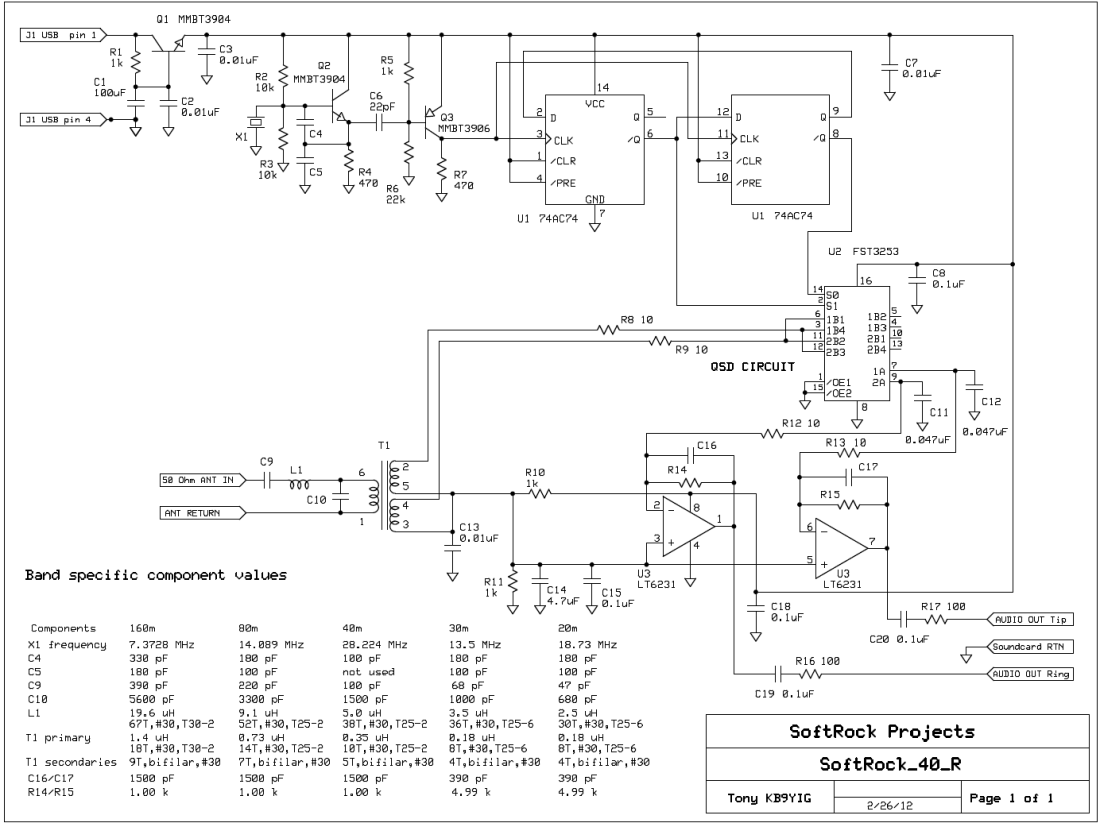Softrock_40_R Home - Softrock 40 R2 USB RX
Band: 20m
Introduction
General Info
Bands
This kit comes in multiple band options: 160m, 80m, 40m, 30m, or 20m (the one I built). If you are building for one of the other bands, click on the "Bands" tab in the above navigation menu to select your band. The system will remember the band so long as you stay connected to the site. Still, it is a good idea to verify the band in the heading of each page, so that, if for some reason the "sticky" band value has somehow reverted back to the default of 20m, you can reselect your desired band.
Good Buid Blog on Facebook
To whet your appetite, check out Dave Watson's Softrock40 build blog on Facebook.
SMT
The most difficult part of this build is making sure you do not lose any of the SMT components. The resistors and capacitors are very small and extremely lightweight. They can be accidentally "launched" by a shaky hand and a bad set of tweezers. Invest in a good set of tweezers and a baking sheet with 0.5-1" walls around the edges. If a chip ever lands in the carpet, you will never find it!
Pix and Tests
This kit's pictures and test results were based upon my build of the kit for the 20m band. Results may vary somewhat for other bands. Frequency-oriented tests show nominal values based upon the crystal frequency for the selected band.
Theory of Operaton
- This receiver is patterned on the classic "direct conversion" receiver, in that it mixes incoming RF down to audio frequencies by, in effect, beating the RF against a Local oscillator such that the mixer products are in the sub 100 kHz range.
- Unlike the traditional DC receiver, the SDR does not "tune" the local oscillator's frequency to beat up against a desired RF signal. Instead, the local oscillator is at a fixed frequency.
- As a result, the (baseband) mixer products can vary in frequency from zero to +/- some theoretically high super-audio frequency. In fact, the practical limit is one-half the soundcard's maximum sampling rate.
- The "tuning" (and demodulation and AFC and other neat radio things) happen in the software part of the Software Defined Radio. It is the magic of Software that makes for the extraordinarily high selectivity in the direct conversion hardware (which is notorious for great sensitivity but terrible selectivity).
- The software requires the mixer's baseband products to be provided to the PC as two separate signals, each identical to the other, except that they are 90 degrees apart in phase ("in quadrature"). The SR Lite II achieves this by dividing the local oscillator's frequency by 4 (with attendant phase shifts to achieve quadrature).
- The output of the divider chain is two signals, I (In-Phase) and Q (Quadrature), identical in all respects but phase i.e., they are "in quadrature"). These signals are harmonically rich, a fact of which the 20m band option takes advantage. This permits us to generate signals whose fundamental frequencies are 4.6825, with a third harmonic of 14.0475 MHz.
- RF from the antenna is bandpass-filtered for the 20m band.
- The two quadrature signals from the Divider stage are fed into the mixer stage, which mixes the third harmonic of the LO, 14.0475 MHz, with the bandpass-filtered 20m RF down to two baseband signals that are also in quadrature and otherwise identical to each other.
- These two signals are provided to an amplifier stage where they are amplified and low-pass filtered to levels acceptable to the PC's soundcard stereo line-in inputs.
- A soundcard which can sample 48 kHz, can digitize an incoming "chunk" of baseband signals from 0 to 24 kHz. Such a soundcard, using its stereo line-in inputs for the I and Q signals, will yield an effective bandwidth of 48 kHz: 24 kHz above the center frequency and 24 kHz below the center frequency. The SDR software in the PC manipulates the digitized I and Q signals to deliver, demodulate, condition, and filter signals within this 48 kHz spectrum.
- Soundcards capable of higher sampling rates (e.g. 96 kHz or 192 kHz) will yield proportionately wider bandwidth, provided their internal audio filters do not cut off the higher audio frequencies.
Board Layouts
Topside
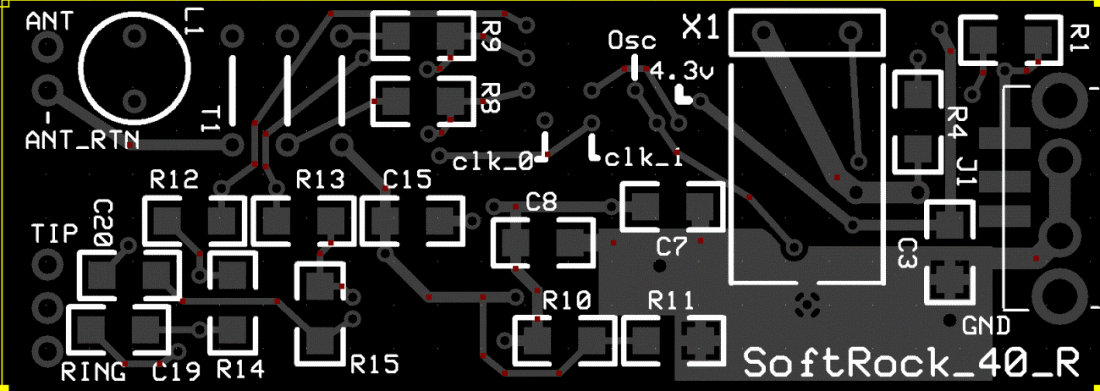
Underside
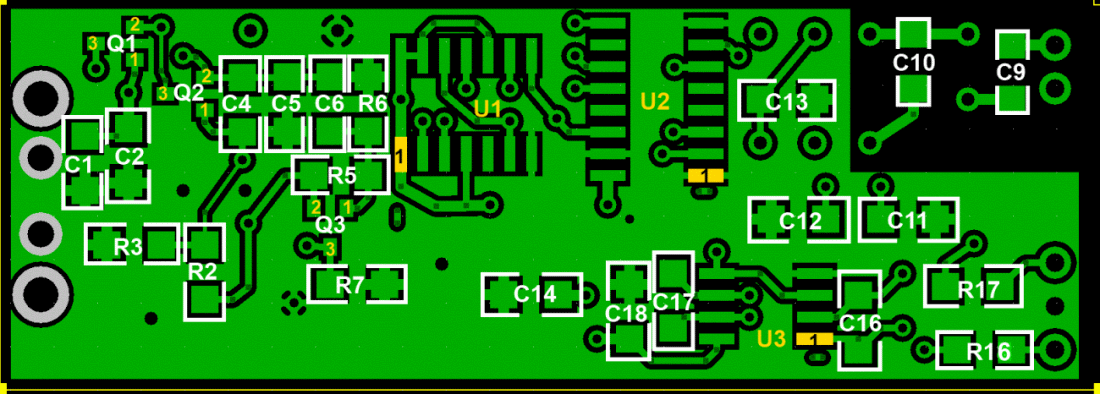
Completed Images
Note: the completed pictures are of the 20m option, which the author built. Other band options (which the author did not build) will appear slightly different (especially the inductors, whose windings and cores will vary by band) for the band-specific components.
Topside

Underside

Background Info
Tools
Winding Inductors
This page has the following inductors:
- L01
COIL: 2.5uH 30T #30 on T25-6 (yellow)
Using approximately 14 inches of #30 wire, wind 30 turns on a 0.25 inch od T25-6 (yellow) ferrite. Inductance = 2.50 uH. - T01
XFRMR: 0.18uH 8T/2x4T bifilar #30 on T25-6 (yellow)
Primary: Using approximately 6 inches of #30 wire, wind 8 turns on a 0.25 inch od T25-6 (yellow) ferrite.
Secondary: Using a total of 6 inches of #30 wire, wind 4 turns , bifilar, on the ferrite in the same direction as the primary winding. Inductance of the single winding (usually the primary) is 0.18 uH.
To learn how to wind coils and transformers, please read the
- tips from the experts and then
- view the excellent videos on KC0WOXs Website
- or take a read of Dinesh's VU2FD guidelines.
- You can review the common construction techniques for inductors for details on deciphering the winding specifications, core specifications,and construction of toroidal and binocular inductors.
Component Identification
After soldering problems, the most common cause of trouble in kit building is the installation of the incorrect component. Most often this is the case with resistors (hint - if voltage or current draw tests are way out of whack, suspect resistors or solder bridges). Invest in a cheap multimeter and MEASURE the resistance. As Pete, M0FMT, said: " ... then you don't have to worry about this modern trend of poor identification of components. I doubt you will find an issue with Tony's kits but measuring is best. A cheap OVA meter costs 2 or 3 bucks and a simple cap bridge is easy to build. (you can search E-Bay for "L/C/F Inductance Capacitance High Precision Meter" and will find several digital L/C meters for $20-$30) These two bits of kit are worth there wieght in gold. Oh and most meters have diode and transistor testers build in... remarkable when you think back to the darkages when I were a lad."
It cannot be overstressed: do not rely solely on the color codes for identification of the correct resistor; ALWAYS measure with your ohmmeter as a double check. Measure twice, cut once.
Soldering
If you are not experienced at soldering (and even if you are somewhat experienced at soldering), refer to excellent tutorial on basic soldering techniques by Tom Hammond N0SS (SK).
This video provides some excellent hints at soldering (and de-soldering) SMT components:
The video below describes techniques for soldering SOIC 14 (and 16 and 8) SMDs
View the above in full-screen mode on Youtube.
You may also want to review the information from the HamNation series on George, W5JDX, and his build of the Softrock Ensemble RXTX. He uses an inexpensive heat gun and Solder paste to install SMT capacitors and ICs. The Session where he introduces the process is in Episode #70 at 36 minutes, 30 seconds into the podcast.
For the more adventurous, there is a process using solder paste and an electric oven called the reflow process, which can be used to install all the SMT chips to one side of the PC Board. This is documented by Guenael Jouchet in the following Youtube segment:
- Read the Primer on SMT Soldering at the Sparkfun site. It is a very good read and it speaks great truths. Then take the time to watch the video tutorial on soldering an SOIC SMD IC.
- Solder Stations. Don't skimp here. Soldering deficiencies
account for 80 percent of the problems surfaced in troubleshooting. It is preferable
to have an ESD-safe station, with a grounded tip. A couple of good stations that
are relatively inexpensive are:
-
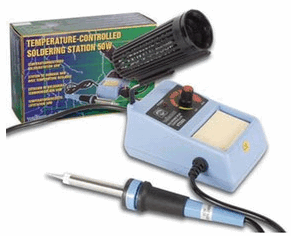 Velleman VTSS5U 50W Solder Station (approx $25 at Frys) (See BGMicro for Spare Tips)
Velleman VTSS5U 50W Solder Station (approx $25 at Frys) (See BGMicro for Spare Tips) -
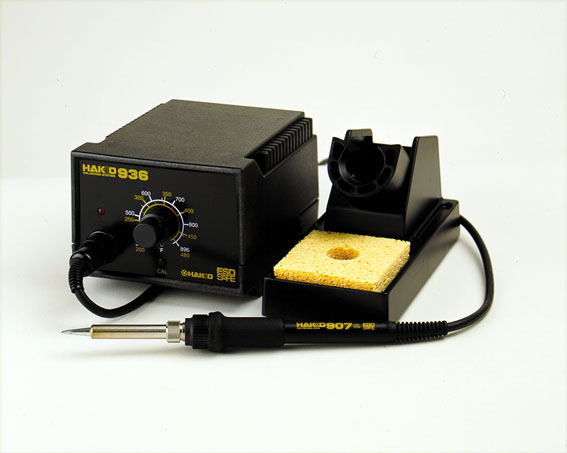 Hakko (Aoyue) 936 ESD Solder Station (under $100)
Hakko (Aoyue) 936 ESD Solder Station (under $100)
-
ESD Protection
You may wish to review the message topic beginning at Message 43554 for a common-sense discussion on ESD.
- Avoid carpets in cool, dry areas.
- Leave PC cards and memory modules in their anti-static packaging until ready to be installed.
- Dissipate static electricity before handling any system components (PC cards, memory modules) by touching a grounded metal object, such as the system unit unpainted metal chassis.
- If possible, use antistatic devices, such as wrist straps and antistatic mats (see Radio Shack's Set for $25 or the JameCo AntiStatic mat for $15)).
- Always hold a PC card or memory module by its edges. Avoid touching the contacts and components on the memory module.
- Before removing chips from insulator, put on the wrist strap connected to the ESD mat. All work with CMOS chips should be done with the wrist strap on.
- As an added precaution before first touching a chip, you should touch a finger to a grounded metal surface.
- If using a DMM, its outside should be in contact with the ground of the ESD mat, and both leads shorted to this ground before use.
- See the review of ESD Precautions at this link.
Work Area
- You will need a well-lit work area and a minimum of 3X magnification (the author uses a cheap magnifying fluorescent light with a 3X lens. This is supplemented by a hand-held 10 X loupe - with light - for close-in inspection of solder joints and SMT installation.
- You should use a cookie sheet or baking pan (with four sides raised approximately a half an inch) for your actual work space. It is highly recommended for building on top of in order to catch stray parts, especially the tiny SMT chips which, once they are launched by an errant tweezer squeeze, are nigh on impossible to find if they are not caught on the cookie sheet.
Misc Tools
- It is most important to solidly clamp the PCB in a holder when soldering. A "third-hand" (e.g., Panavise or the Hendricks kits PCB Vise) can hold your board while soldering. In a pinch, you can get by with a simple third-hand, alligator clip vise. Jan G0BBL suggests "A very cheap way is to screw a Large Document Clip to a woodblock which will clamp the side of a PCB."
- Magnifying Head Strap
- Tweezers (bent tip is preferable).
- A toothpick and some beeswax - these can be used to pickup SMT devices and hold them steady while soldering.
- Diagonal side cutters.
- Small, rounded jaw needle-nose pliers.
- Set of jewelers' screwdrivers
- An Exacto knife.
- Fine-grit emery paper.
